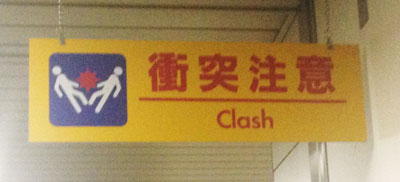
X Clash
Tim says:
I have a few theories about this very strange sign:
- The picture shows people “slam-dancing” to the music of the ’80s punk group, the Clash
- Since “clash” can mean “a violent confrontation”, such as a fight, perhaps the two people in the picture are fighting by simply running into each other, instead of using weapons or their fists
- Each person in the picture is shocked by how the clothes worn by the other person “clash” — that is, the colors of the clothes don’t look good together. So both people are fainting because they can’t believe how badly the colors clash
- The person who designed this sign didn’t know a good way to translate 「衝突注意」!(Or perhaps they meant “crash”?)
「衝突」in English is “collision”, not “clash”. However, “beware of collisions” is a little unclear. Perhaps we could say:
O Be careful when rounding corner
Ayumi says:
“clash” は、意見の衝突や思想の対立、または色などの見た目がぶつかっているときに使います。
絵にあるような「衝突」は “collision” または “crash” など。
でも、名詞を示すだけでは「衝突注意」との喚起にはなりません。
ましてや、crashを動詞と考えると「衝突しろ!」との命令になりとても変。注意をするのならば、Be careful not to collide with each other…などとなるのでしょうけれど、
意図して衝突しようとする人がいるわけでもなく、結局伝えたいのは「角を曲がるときに気をつけて!」ということなのでしょう。本当に日本人は名詞だけで話そうとする、、、「飯」「金」
「飯」をどうする?
「金」がどうした?
いつものことながら、以心伝心の「名詞文化」をそのまま英語にすることには無理があります(笑)
田中亜由美は「TOEICテスト クロストレーニング PART 1・2」などの本は販売中!ブログはこちら.
周囲にある英語を見て、果たしてそれが正しい英語なのだろうかと感じる英語はありますか?「あの英語は絶対に間違っている」という英語の表記はありますか?看板の写真を撮って、Machigai.comに送りましょう!とんでもない英語だったら、このコーナーで出します!



